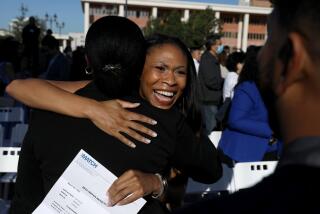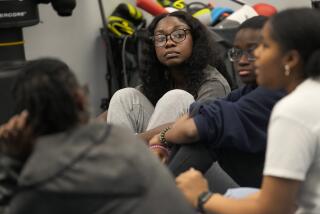An Objection to Law School : Fewer lawyers in our future? Well, applications <i> are </i> down. And then there’s that ‘image’ problem . . .
- Share via
Rejoice all ye lawyer bashers: From this year forward there might be fewer attorneys in the world to kick around.
Law schools from the East Coast to Westwood are reporting 8% to 12% declines in applications this year as compared to last. As for the reasons, there’s a lot of hearsay. One popular verdict: Blame the trial of O.J.
The ugliness of F. Lee Bailey versus Marcia Clark is a reality check for those who bought into the leather-and-luxury image of the late “L.A. Law.” As a result, applications continue to slide from the peak year of 1991 (also the peak of popularity for “L.A. Law”).
“Back in the ‘80s and early ‘90s, certainly ‘L.A. Law’ was a very positive, glamorous portrayal of what it was like to be a lawyer,” says University of Oregon Law School Dean Charles O’Kelley. “Recently what you see is the O.J. trial and the Menendez trial. You see attorneys acting less mature than you would like.”
Perhaps seeing Corbin Bernsen drive a Porsche after a leisurely day of settling divorce cases is more glamorous than the reality of Bailey saying Clark’s “eyesight is as bad as her memory” live on national television.
“People are looking at the O.J. trial and the Menendez trial and turning away,” says Michael Rappaport, dean of admissions at UCLA School of Law, where applications are down about 10% from last year.
“Our peak in applications occurred when ‘L.A. Law’ was popular,” Rappaport adds. “Now that all the doctor shows are popular on TV, we seem to be losing.”
Medical schools are expecting a 1.3% increase in applications this year, possibly due in part to NBC’s “E.R.,” according to the American Assn. of Medical Colleges. But, despite the tendency to blame the Simpson case for the law’s decreasing popularity, the story is more complicated than linking career choices to television.
The job market isn’t what it used to be. The same people who created the biggest year for applications in 1991 (when 94,000 people tried to get into law school for 44,100 positions) are now in the real world. “What is dissuading students these days is just the fact that there are so many lawyers driving taxis and garbage trucks,” argues Walt Cople, criminal justice chair at the Metropolitan State College of Denver.
Members of the law school class of ‘93, for example, faced the lowest hiring prospects of any class in the last 10 years, according to the National Assn. for Law Placement.
Another factor is a dip in the student population, which coincides with the “baby bust” birth years of the early ‘70s. College attendance has been down since 1992, the biggest graduating college class in U.S. history. And baby busters “are finally hitting the law school age range,” says Lujuana Treadwell, assistant dean at Boalt Hall School of Law at UC Berkeley.
And the price is high. At Boalt Hall, tuition is $7,068 a year, plus a recently added $2,000 flat fee. Out-of-state students pay $7,699 on top of all that. At USC, the annual cost is $20,020.
That’s more than $60,000 to enter a profession that many argue has lost its luster.
The increasingly ugly image of greedy corporate lawyers, lawyer-politicians and midnight pitchmen with memorable 800 numbers has transformed law from a profession of concern and conscience to one of slime and shame, say some.
As author Sol Linowitz puts it in his book, “The Betrayers of the Profession” (Macmillan, 1994), lawyers “have taken a calling that sought the good society and twisted it into an occupation that seems intent primarily on seeking a good income.”
*
Yet, not all students are dissuaded--not even by the trial of Orenthal James Simpson. Many, in fact, are inspired.
At Loyola Law School, which claims Simpson lawyers Johnnie L. Cochran and Robert F. Shapiro as alumni, applications are bucking the national trend: They’re nearly at the same level as last year. Anton Mack, director of admissions, says the ascent of Cochran and Shapiro to household namehood inspired many of the 3,800 applicants who will be competing for 450 positions this year.
“People come up to me when I recruit around the country and they say, ‘You’re the school Robert Shapiro went to,’ ” Mack says.
“A lot of people,” he says, “find that appealing.”
At the USC Law Center, “We’re at a 1% increase over last year’s applications,” says Bill Hoye, director of admissions. “Applicants . . . are drawn to L.A. because of the prominent trials.”
Many women are drawn closer to legal studies because of Marcia Clark. Despite her bickering with Bailey, Clark has emerged as a hero to some students.
“It’s very inspiring the first time you see a woman like Clark in this type of position,” says Michelle Zamarin, a Franklin and Marshall College senior who plans to study law at Boston University next fall. “I’m interested in doing trial law, Marcia Clark’s type of law.”
“She’s an inspiration to me,” adds Sally Ann Davidson, a senior at Metropolitan State who plans to apply to law school. “She’s very gutsy and she knows the law.”
“You read that this trial has had the effect of making people think less of the legal system,” says John Garic, a pre-law adviser at Pennsylvania’s Franklin and Marshall. “But . . . female students see Marcia Clark’s participation as another step on the road to equality.”






